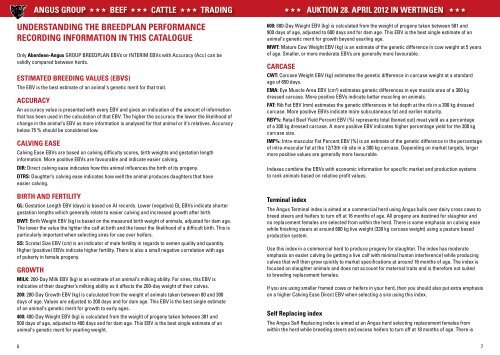Create successful ePaper yourself
Turn your PDF publications into a flip-book with our unique Google optimized e-Paper software.
ANGUS GROUP ★ ★ ★ BEEF ★ ★ ★ CATTLE ★ ★ ★ TRADING<br />
UNDERSTANDING THE BREEDPLAN PERFORMANCE<br />
RECORDING INFORMATION IN THIS CATALOGUE<br />
Only Aberdeen-<strong>Angus</strong> GROUP BREEDPLAN EBVs or INTERIM EBVs with Accuracy (Acc) can be<br />
validly compared between herds.<br />
ESTIMATED BREEDING VALUES (EBVS)<br />
The EBV is the best estimate of an animal‘s genetic merit for that trait.<br />
ACCURACY<br />
An accuracy value is presented with every EBV and gives an indication of the amount of information<br />
that has been used in the calculation of that EBV. The higher the accuracy the lower the likelihood of<br />
change in the animal‘s EBV as more information is analysed for that animal or it‘s relatives. Accuracy<br />
below 75 % should be considered low.<br />
CALVING EASE<br />
Calving Ease EBVs are based on calving diffi culty scores, birth weights and gestation length<br />
information. More positive EBVs are favourable and indicate easier calving.<br />
DIR: Direct calving ease indicates how this animal infl uences the birth of its progeny.<br />
DTRS: Daughter’s calving ease indicates how well the animal produces daughters that have<br />
easier calving.<br />
BIRTH AND FERTILITY<br />
GL: Gestation Length EBV (days) is based on AI records. Lower (negative) GL EBVs indicate shorter<br />
gestation lengths which generally relate to easier calving and increased growth after birth.<br />
BWT: Birth Weight EBV (kg) is based on the measured birth weight of animals, adjusted for dam age.<br />
The lower the value the lighter the calf at birth and the lower the likelihood of a diffi cult birth. This is<br />
particularly important when selecting sires for use over heifers.<br />
SS: Scrotal Size EBV (cm) is an indicator of male fertility in regards to semen quality and quantity.<br />
Higher (positive) EBVs indicate higher fertility. There is also a small negative correlation with age<br />
of puberty in female progeny.<br />
GROWTH<br />
MILK: 200-Day Milk EBV (kg) is an estimate of an animal‘s milking ability. For sires, this EBV is<br />
indicative of their daughter’s milking ability as it affects the 200-day weight of their calves.<br />
200: 200-Day Growth EBV (kg) is calculated from the weight of animals taken between 80 and 300<br />
days of age. Values are adjusted to 200 days and for dam age. This EBV is the best single estimate<br />
of an animal‘s genetic merit for growth to early ages.<br />
400: 400-Day Weight EBV (kg) is calculated from the weight of progeny taken between 301 and<br />
500 days of age, adjusted to 400 days and for dam age. This EBV is the best single estimate of an<br />
animal‘s genetic merit for yearling weight.<br />
★ ★ ★ <strong>AUKTION</strong> 28. APRIL 2012 IN WERTINGEN<br />
6 7<br />
★ ★ ★<br />
600: 600-Day Weight EBV (kg) is calculated from the weight of progeny taken between 501 and<br />
900 days of age, adjusted to 600 days and for dam age. This EBV is the best single estimate of an<br />
animal‘s genetic merit for growth beyond yearling age.<br />
MWT: Mature Cow Weight EBV (kg) is an estimate of the genetic difference in cow weight at 5 years<br />
of age. Smaller, or more moderate EBVs are generally more favourable.<br />
CARCASE<br />
CWT: Carcase Weight EBV (kg) estimates the genetic difference in carcase weight at a standard<br />
age of 650 days.<br />
EMA: Eye Muscle Area EBV (cm2 ) estimates genetic differences in eye muscle area of a 300 kg<br />
dressed carcase. More positive EBVs indicate better muscling on animals.<br />
FAT: Rib Fat EBV (mm) estimates the genetic differences in fat depth at the rib in a 300 kg dressed<br />
carcase. More positive EBVs indicate more subcutaneous fat and earlier maturity.<br />
RBY%: Retail Beef Yield Percent EBV (%) represents total (boned out) meat yield as a percentage<br />
of a 300 kg dressed carcase. A more positive EBV indicates higher percentage yield for the 300 kg<br />
carcase size.<br />
IMF%: Intra-muscular Fat Percent EBV (%) is an estimate of the genetic difference in the percentage<br />
of intra-muscular fat at the 12/13th rib site in a 300 kg carcase. Depending on market targets, larger<br />
more positive values are generally more favourable.<br />
Indexes combine the EBVs with economic information for specifi c market and production systems<br />
to rank animals based on relative profi t values.<br />
Terminal index<br />
The <strong>Angus</strong> Terminal index is aimed at a commercial herd using <strong>Angus</strong> bulls over dairy cross cows to<br />
breed steers and heifers to turn off at 16 months of age. All progeny are destined for slaughter and<br />
no replacement females are selected from within the herd. There is some emphasis on calving ease<br />
while fi nishing steers at around 600 kg live weight (330 kg carcase weight) using a pasture based<br />
production system.<br />
Use this index in a commercial herd to produce progeny for slaughter. The index has moderate<br />
emphasis on easier calving (ie getting a live calf with minimal human interference) while producing<br />
calves that will then grow quickly to market specifi cations at around 16 months of age. The index is<br />
focused on slaughter animals and does not account for maternal traits and is therefore not suited<br />
to breeding replacement females.<br />
If you are using smaller framed cows or heifers in your herd, then you should also put extra emphasis<br />
on a higher Calving Ease Direct EBV when selecting a sire using this index.<br />
Self Replacing index<br />
The <strong>Angus</strong> Self Replacing index is aimed at an <strong>Angus</strong> herd selecting replacement females from<br />
within the herd while breeding steers and excess heifers to turn off at 18 months of age. There is


